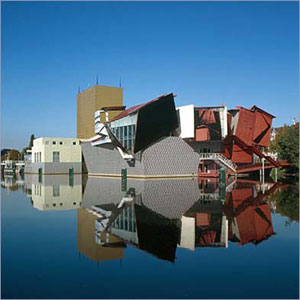There have been always two main school of thoughts for architects. Abstract and Empirical.
Abstract is the form of thinking that is based on the cognitive process of abstraction, which is defined as:
Process by which allegedly we form concepts on the basis of experience or of other concepts. On being confronted with red things, each of which has many other properties, we abstract the redness and so form a concept of red. Empiricists like Lock use abstraction to help specify how we build up our concepts on the basis of experience.
(A.R. Lacey: A Dictionary of Philosophy, Routledge, 1986)
 The concert hall of Santa Cruz de Tenerife. Designed by the architect Santiago Calatrava
The concert hall of Santa Cruz de Tenerife. Designed by the architect Santiago Calatrava
In archietcture, we can always refer to Frank Gehery as a abstract thinker. His buldings are in actual abstraction.
Whereas Emperical thinking is the thinking based on experience and empiric data acquired through our bodily senses. As contrasted to Absolute or Apriori Thinking, empirical thought draws heavily on the material provided by the body and therefore is liable to errors, illusions, prejudice, misconceptions, etc. More generally, it is the thinking implicit in the philosophy of empiricism, positivism, scientificism, physicalism or other similar views that emphasize the primacy of matter over mind.

This violin piano house was built recently in An Hui Province, China
When students step into architecture they tend to design what they actually see in life.For example if they have to design a musician’s house they would make it in guitar. Whereas the musical building perceived in abstraction would come up like Frank Gehry’s Experince Music Project building, Seattle Center, WA.


I would like to refer to a letter written to architecture students by Harley Hahn about abstraction and architecture:
“Your teacher asked me if I had a few words relating to abstraction and architecture, and why it is so difficult for students to bridge the apparent gap between the two.
I do have some words for you, and here they are—
Young architecture students struggle to deal with the inherent contradictions between what they do and how they think. On the one hand, it is easy to see that thoughts about ideas are abstract; they exist only in the mind of the thinker. Architecture, however, is firmly grounded in three-dimensional reality. How then, can abstract thinking be so important to someone who works in the physical reality of three dimensions?
To answer this, let me start with a basic question: What is architecture? The short answer is that architecture is the art of designing structures. But let’s take a moment to dig a bit deeper.
An architect designs the visual appearance of structures: how they are arranged in space. He selects building materials, for both external and internal needs. He designs lighting systems, mechanical systems, electrical systems, plumbing systems, furnishings, and decorations.
What do all these things have in common? They involve concrete objects: things you can touch — materials that have mass, take up space, have specific physical characteristics, and (not least) cost money.
The mere act of even thinking about these things requires what is called structural visualization: the ability to “see” ideas and patterns in three-dimensions.
To be an architect, you need the have this trait in abundance. We can assume that, simply because you are sitting here in a classroom in an architecture school, you have all been blessed with a higher than average amount of structural visualization.
You should know that structural visualization is an in-born aptitude. In fact, it is the very same aptitude that is necessary to be an engineer (except, of course, that engineers aren’t as smart or as good-looking as architects).

The Groninger Museum designed by Italain architect Alessandro Mendini
Studies show that, if you have this aptitude, you were born with it and, in most cases, you inherited it from your mother (which explains why so many men who like to fix and build things, don’t understand when their sons don’t like to fix and build things).
However, thinking about ideas and patterns in a spatial manner is only one way to see the world. The best architects are also able to see the world in a totally different way: as a collection of abstractions that fit together in non-physical patterns. In other words, the best architects are able to think both structurally and abstractly, often at the same time.
At first glance, abstract visualization does not seem to be the province of architects. It is used more by philosophers, creative writers, historians, lawyers, actors, and so on. Such people earn their keep by seeing the world in terms of intangible ideas.
However, let me explain why it is useful for an architect — who naturally sees the world in structural terms — to also be able to think about things that cannot be visualized (which is the definition of abstraction).
To be sure, your end product — the structures you design and build — must be visualized. You can’t live or work in a building that doesn’t exist in physical space. However, just think for a moment about the process of getting ideas; the act of thinking about them; and the judgment it takes to decide which ideas you want to use as the basis for a particular piece of work.

 Again examples of an Empirical thought
Again examples of an Empirical thought
There are many ways to get from here to there, but the architect who can think only in three-dimensions has limited choices. This is far more important than you might think. If you neglect to think abstractly at the beginning of a project, you will limit yourself enormously.
For example, suppose you want to design a building to be used as a music museum. Which will work better: a design based on the idea of music (an abstraction), or a design based on the physical image of a guitar?
You might think the answer is obvious, and that I am exaggerating to make my point. After all, no one would actually design a structure based on “guitar-ness”. Well, someone did design such a structure. It is in Seattle, and it is horrible.
Let’s take another example: the new Getty Museum in Los Angeles. When you are inside the buildings, visiting the display areas, you will have a warm, comfortable, inspiring feeling, just the sort of feeling you want when you look at works of art.
However, when you are outside the buildings, walking around the museum’s vast patio area, you will feel out of place. As an architecture student, you will have no trouble seeing that, whatever merits the overall design of the Getty Museum might have, making human beings feel comfortable is not one of them. The arrangement is totally out of proportion to human scale, almost as if it was designed on purpose to intimidate visitors.

Getty Museum, Los Angeles
Of course, this was not the case. The architect did not set out to design something to make you feel uncomfortable. What is the case is that the architect did not start with enough abstract thinking — which meant that, ultimately, in his attempt to break new ground (if you can forgive yet another pun), he relied too much on the physical, and not enough on the emotional. The result is discomfort.
When you design, please remember that, although most people can think structurally, everyone feels abstractly. If you aren’t able to think about abstractions when you begin a design, you will never be able to control the way people feel when they visit your buildings.
All of this raises the question: Can people who are high in structural visualization learn how to think abstractly? And if so, how?
Well, I am a person who is high in structural visualization. I went to graduate school in computer science. I can think three-dimensionally, both in my head and with things I can hold in my hand, but I have also learned to think abstractly. I can write philosophically (as you can see), and I can paint abstractly (as you will see if you visit my Web site).
Like you, I have a bent towards the physical world. Like you, I also find that structural thinking comes easy to me. This doesn’t mean, however, that I can’t think of abstractions. It just means that it is not easy or natural, and that I had to teach myself how do to so. And if I can do it, you can do it.
So what is my advice? Do what you need to do to open that other side of your thinking. Believe me, it is there: you only have to put in the effort to think in a different way from what you are used to, and then you have to practice.
Please don’t worry about losing what you have. Just because you learn to think in a new way doesn’t mean you forget how to think in the old way. Instead, you will be the best of all possible architects, one who can think in two opposite ways at the same time.
My guess is that your teacher has some ideas on how you might start to learn new thinking skills. Don’t let it bother you if doing so seems slow. And don’t get discouraged if, at first, you can’t understand what you are hearing, reading, or seeing.
After all, to a philosopher, abstraction is easy, but he would have a lot of trouble thinking the way you do. That doesn’t mean that he shouldn’t learn how to do so, at least a little bit. If he does, he’ll be a better philosopher.
Realize that being naturally structural or naturally abstract are opposite sides of the same coin. Both are worthwhile, but to the extent that one is easy for you, the other will be difficult.
The ability to use your structural visualization talent matures in your late teens and declines after the age of 30. This means that the older people in your field will naturally find abstraction somewhat easier than do you, and will be drawn to it more readily. Perhaps this is why you can’t understand why your teachers want you to learn how to think “outside the box”. Perhaps this is why they can’t understand why doing so is such a challenge for you.
When you are a structural person, dealing with abstraction can be difficult, at least at first. After all, so much of our world is physical, that it even creeps into the way we think and talk. For example, consider some of the expressions I used in this short essay: being firmly grounded, digging a bit deeper, breaking new ground, thinking outside the box, and so on. All of these are physical metaphors that express ideas that are completely abstract.
Old habits are strong, but we need to break them if we are to be all that we can be. So the next time you see someone enjoying something abstract, something that makes no sense to you, tell yourself that there must be value in what he or she is doing. Then tell yourself that you will not be satisfied until you are able to do the same, at least a little bit.”
